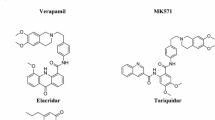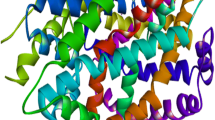Abstract
The apical sodium-codependent bile acid transporter (ASBT) inhibition activity of benzothiepine derivatives have been analyzed based on topological and molecular features. Analysis of the structural features in conjunction with the biological endpoints in Combinatorial Protocol in Multiple Linear Regression (CP-MLR) led to the identification of 21 descriptors for modeling the activity. The study clearly suggested that the role of Randic shape index (path/walk ratio 3) and topological charges of 2-, 5-, and 6-orders to optimize the ASBT inhibitory activity of titled compounds. The influence of atomic van der Waals volumes, masses, Sanderson electronegativities, and polarizabilities are indicated via different lags of Moran and Geary autocorrelations. Presence of tertiary aromatic amine functionality in molecular structure has also shown its relevance in rationalizing the biological actions of benzothiepines. The PLS analysis has confirmed the dominance of information content of CP-MLR identified descriptors for modeling the activity when compared to those of the leftover ones.
Similar content being viewed by others
References
Stark RM (1996) Review of the major intervention trials of lowering coronary artery disease risk through cholesterol reduction. Am J Cardiol 8: 13–19
Expert Panel on Detection, Evaluation, and Treatment of High Blood Cholesterol in Adults (2001) Executive summary of the third report of the National Cholesterol Education Program (NCEP) Expert Panel on Detection, Evaluation, and Treatment of High Blood Cholesterol in Adults (Adult Treatment Panel III). J Am Med Assoc 285:2486–2497. http://www.nhlbi.nih.gov/guidelines/cholesterol/atp3xsum.pdf
Stedronsky ER (1994) Interaction of bile acids and cholesterol with non-systemic agents having hypocholesterolemic properties. Biochim Biophys Acta 1210: 255–287
Tremont SJ, Lee LF, Huang H-C, Keller BT, Banerjee SC, Both SR, Carpenter AJ, Wang C-C, Garland DJ, Huang W, Jones C, Koeller KJ, Kolodziej SA, Li J, Manning RE, Mahoney MW, Miller RE, Mischke DA, Rath NP, Fletcher T, Reinhard EJ, Tollefson MB, Vernier WF, Wagner GM, Rapp SR, Beaudry J, Glenn K, Regina K, Schuh JR, Smith ME, Trivedi JS, Reitz DB (2005) Discovery of potent, nonsystemic apical sodium-codependent bile acid transporter inhibitors (Part 1). J Med Chem 48: 5837–5852. doi:10.1021/jm040215
ChemDraw Ultra 6.0 and Chem3D Ultra. Cambridge Soft Corporation, Cambridge, USA. Available online at http://www.cambridgesoft.com
Dewar MJS, Zoebisch EG, Healy EF, Stewart JJP (1985) AM1: a new general purpose quantum mechanical molecular model. J Am Chem Soc 107: 3902–3909. doi:10.1021/ja00299a024
Todeschini R, Consonni V (2001) DRAGON software (version 1.11-2001). Milano, Italy. Available online at http://www.talete.mi.it/dragon.htm
Golbraikh A, Tropsha A (2002) Beware of q 2. J Mol Graph Model 20: 269–276. doi:10.1016/S1093-3263(01)00123-1
Prabhakar YS (2003) A combinatorial approach to the variable selection in multiple linear regression: analysis of Selwood et al data set—a case study. QSAR Comb Sci 22: 583–595. doi:10.1002/qsar.200330814
Wold S (1978) Cross-validatory estimation of the number of components in factor and principal components models. Technometrics 20: 397–405
Kettaneh N, Berglund A, Wold S (2005) PCA and PLS with very large data sets. Comput Stat Data Anal 48: 69–85. doi:10.1016/j.csda.2003.11.027
Stahle L, Wold S (1988) Multivariate data analysis and experimental design in biomedical research. In: Ellis GP, West WB (eds) Progress in medicinal chemistry. Elsevier, Amsterdam, pp 291–338
Sharma S, Prabhakar YS, Singh P, Sharma BK (2008) QSAR study about ATP-sensitive potassium channel activation of cromakalim analogues using CP-MLR approach. Eur J Med Chem 43: 2354–2360. doi:10.1016/j.ejmech.2008.01.020
Sharma S, Sharma BK, Sharma SK, Singh P, Prabhakar YS (2009) Topological descriptors in modeling the agonistic activity of human A 3 adenosine receptor ligands: the derivatives of 2-Chloro-N 6-substituted-4′-thioadenosine-5′-uronamide. Eur J Med Chem 44: 1377–1382. doi:10.1016/j.ejmech.2008.09.022
Singh P, Kumar R, Sharma BK, Prabhakar YS (2009) Topological descriptors in modeling malonyl coenzyme A decarboxylase inhibitory activity: N-Alkyl-N-(1,1,1,3,3,3-Hexafluoro-2-hydroxypropylphenyl)amide derivatives. J Enzyme Inhib Med Chem 24: 77–85. doi:10.1080/14756360801915336
Sharma BK, Sharma SK, Singh P, Sharma S, Prabhakar YS (2009) Modeling of vascular endothelial growth factor receptor 2 (VEGFR2) kinase inhibitory activity of 2-anilino-5-aryloxazoles using chemometric tools. J Enzyme Inhib Med Chem 24: 86–93. doi:10.1080/14756360801915351
Sharma BK, Pilania P, Sarbhai K, Singh P, Prabhakar YS (2009) Chemometric descriptors in modeling the carbonic anhydrase inhibition activity of sulfonamide and sulfamate derivatives. Mol Divers. doi:10.1007/s11030-009-9181-5
Akaike H (1973) Information theory and an extension of the minimum likelihood principle. In: Petrov BN, Csaki F (eds) Second international symposium on information theory. Akademiai Kiado, Budapest, pp 267–281
Akaike H (1974) A new look at the statistical identification model. IEEE Trans Automat Contr AC-19:716–723. Available online at http://ieeexplore.ieee.org/xpl/tocresult.jsp?isYear=1974&isnumber=24140&Submit32=View+Contents
Kubinyi H (1994) Variable selection in QSAR studies. I. An evolutionary algorithm. Quant Struct-Act Relat 13: 285–294. doi:10.1002/qsar.19940130306
Kubinyi H (1994) Variable selection in QSAR studies. II. A highly efficient combination of systematic search and evolution. Quant Struct-Act Relat 13: 393–401. doi:10.1002/qsar.19940130403
Friedman J (1990) Multivariate adaptive regression splines. Technical report no. 102. Laboratory for computational statistics. Stanford University, Stanford
So S-S, Karplus M (1997) Three-dimensional quantitative structure-activity relationship from molecular similarity matrices and genetic neural networks. 1. Method and validation. J Med Chem 40: 4347–4359. doi:10.102/jm970487v
Prabhakar YS, Solomon VR, Rawal RK, Gupta MK, Katti SB (2004) CP-MLR/PLS directed structure–activity modeling of the HIV-1 RT inhibitory activity of 2,3-Diaryl-1,3-thiazolidin-4-ones. QSAR Comb Sci 23: 234–244. doi:10.1002/qsar.200330854
Gramatica P (2007) Principles of QSAR models validation: internal and external. QSAR Comb Sci 26: 694–701. doi:10.1002/qsar.200610151
Author information
Authors and Affiliations
Corresponding author
Rights and permissions
About this article
Cite this article
Sharma, B.K., Singh, P., Pilania, P. et al. CP-MLR/PLS directed QSAR study on apical sodium-codependent bile acid transporter inhibition activity of benzothiepines. Mol Divers 15, 135–147 (2011). https://doi.org/10.1007/s11030-009-9220-2
Received:
Accepted:
Published:
Issue Date:
DOI: https://doi.org/10.1007/s11030-009-9220-2




